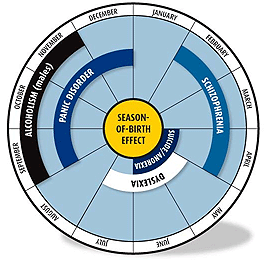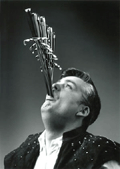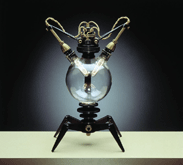

Does the time of year you’re born affect your mental state — and your potential for developing some form of mental illness? According to this interesting piece in the New Scientist, researchers are beginning to think so. The idea actually goes back all the way to 1929, when the Swiss scientist Moritz Tramer noted that people born in late winter were much more likely to develop schizophrenia later in life; indeed, that correlation has been verified in so many followup studies that one study argued “the increased risk of schizophrenia that comes with a winter birthday is almost twice the increase in risk linked to having a parent or sibling with the disorder.”
But assuming the connection is true, why would it occur? The obvious culprit is sunlight, the major time-of-year variable. Since sunlight affects levels of everything from melatonin to vitamin D and various neurotransmitters, these could be causing changes in a pregnant mother that have carryover effects on a fetus and its development.
Obviously, this is pretty subtle stuff, and still pretty conjectural. But one of the more fasinating hypotheses is that one’s likelihood of becoming anorexic could be linked to the time of year in which you’re born. Here’s a longish excerpt:
Beth Watkins, an eating disorder researcher at St George’s Hospital Medical School in London, has suggested a more subtle reason for the season-of-birth link to anorexia, which follows a similar pattern to that for suicide. Her idea is not that the seasons cause changes in the fetus, but rather that seasonal effects allow babies vulnerable to the condition to be conceived and born only at certain times of the year. People with anorexia are eight times as likely as the general population to have a parent or sibling with the disorder. Often that relative is the mother, and this got Watkins thinking. Was there something about overly thin mothers that might vary by season? “Their actual fertility is on a knife-edge,” she says, and babies born in the months most strongly linked to anorexia were conceived in July to September — which follow the northern hemisphere’s warmest months. Could the higher temperature allow an anorexic mother to conserve just enough energy to tip her into a fertile state?
Watkins and her colleague Kate Willoughby looked at a sample of nearly 400 women in the UK with anorexia and other eating disorders. In the UK, only in the summer months of July and August does the average monthly temperature tend to rise above 15 °C, and in keeping with Watkins’s hypothesis, significantly more people with anorexia had been conceived during these warmest months. They then collected data on 200 patients in Australia living in and around Sydney, where average temperatures drop below 15 °C only in the winter months of June, July and August. Sure enough, they found that fewer had been conceived in these cooler months. Finally, they looked at a sample of people with anorexia from Singapore, where the temperature remains constant at over 25 °C all year round. There they found no season-of-birth effect at all.
Intriguing stuff, to be sure. Also check out that chart above: It lets you calculate what sort of disorders are correlated to what parts of the year. Click on here for a larger version!

Man, these things just keep getting more and more gigantic: Fishermen off the coast of New Zealand were out catching patagonian toothfish when they snared Mesonychoteuthis hamiltoni — a colossal squid, the 747 of the briny deep. At 990 pounds and 39 feet long, it’s 50% larger than the next biggest specimen ever caught; and since colossal squid are assumed to grow to a maximum of 46 feet, it’s pretty close to being the biggest one you could catch.
Though who knows? The 46-foot estimate is based on studying the occasional colossal-squid corpse accidentally caught in nets or washed up on shores, so maybe these majestic beasts grow larger yet. At which point it makes you wonder, to what increasingly florid adjectives might we one day be forced to resort? What comes after “giant squid” and “colossal squid”, anyway? “Ginormous squid”? “Just-totally-way-huge squid”? My favorite quote from an Associated Press article on the catch:
“I can assure you that this is going to draw phenomenal interest. It is truly amazing,” said Dr. Steve O’Shea, a squid expert at the Auckland University of Technology. If calamari rings were made from the squid they would be the size of tractor tires, he added.
Nice. Mind you, given that the flesh of colossal squid are deeply infused with ammonia — to make them neutrally bouyant, neither rising nor falling in the water — that would be some rather nasty-tasting hors d’ouerves.
(Thanks to Frances, Joseph and Will for this one!)

Apparently snow-machine technology has become so cheap that family-sized devices are now available for $525 to $2,400. The upshot is the creation of a new class of snow geeks — parents obsessed with, in snowless-but-cold winters, generating improbably huge piles of snow beside their houses for the wee ones to cavort upon. There’s a surreal little piece by Penelope Green in today’s New York Times describing the culture:
Those who make snow are proud of their powder. They speak passionately about its stacking qualities (it is denser than snow that starts out in a cloud) and bandy about terms like nucleation and wet bulb temperature. Forums like snowguns.com, which has over 3,700 members, show a subculture as much into the process of snowmaking as the result of it. There are discussions about how to build your own rope tow and lengthy back-and-forths about the attributes of various snow wand nozzles.
My favorite quote in the article is from one of the fathers: “When real snow falls, Mr. Young said, ‘my daughter thinks I made it.’”

“Sword swallowers,” writes radiologist Brian Witcombe, “know their occupation is dangerous.” But how dangerous? Witcombe discovered there weren’t any good data on sword-swallowing injuries, so he teamed up with Dan Meyer, the executive director of the Sword Swallowers’ Association International, to survey 110 sword swallowers and find out about their job-related injuries. The resulting paper — “Sword swallowing and its side effects” — was published in the December 2006 issue of the British Medical Journal.
I read many scientific studies that get me excited — but I’ve never encountered one that so frequently made me wince. Apparently one of the biggest dangers in sword swallowing, the authors found, was “distractions”:
For example, one swallower lacerated his pharynx when trying to swallow a curved sabre, a second lacerated his oesophagus and developed pleurisy after being distracted by a misbehaving macaw on his shoulder, and a belly dancer suffered a major haemorrhage when a bystander pushed dollar bills into her belt causing three blades in her oesophagus to scissor.
Belly dancing while swallowing swords? Ay yi yi. Other hair-raising, gothic details include a swallower whose sword “brushed his heart”, oesophageal perforation, and sore throats caused by “odd shaped or multiple swords”.
Man, this stuff reads like it was ghostwritten by Edgar Allan Poe. Another interesting trivia point: Apparently, the Sword Swallowers’ Association International only recognises “those who can swallow a non-retractable, solid steel blade at least two centimetres wide and 38 centimetres long.”
(Thanks to the Book of Joe for this one!)

The wits over at the Science Creative Quarterly — a science-humor publication that started up back in 2005 — have posted a funny parody: A version of the Boy Scouts for scientists. The official name is the “Order of the Science Scouts of Exemplary Repute and Above Average Physique”, and they have a truly hilarious list of badges. I went down the list and figured out which badges I qualified for, and listed them above. They are:
The “talking science” badge: “Assumes the recipient conducts himself/herself in such a manner as to talk science whenever he/she gets the chance.”
The “MacGyver” badge: “In which the recipient has demonstrated that his/her science communciation prowess was handy in simplifying a potentially challenging scenario.” Among other things, I frequently draw up equations to add ludicrous levels of precision to otherwise mundane tasks.
The “I blog about science” badge: Self evident.
The “inordinately fond of invertebrate” badge: “In which the recipient professes an arguably unhealthy affinity for things of this category.”
Go check out the rest of the list! I wonder if there’s any sort of Cafe Press-like operation online that could actually physically make copies of these badges on an a la carte basis? I would so totally order those four.
(Thanks to Debbie for this one!)

This is lovely: Aaron Koblin took what appears to be a single day’s worth of air-traffic over the US, and turned the data for each flight into a gorgeously shifting and moving video of dots. My favorite point in the video comes halfway through, when he zooms in on the west coast and points out that …
WITHOUT GEOGRAPHY
LANDMARKS AND PATTERNS
EMERGE
… which itself is like a nice little psychogeographic haiku. it’s also literally true: In the video, you watch as the locations of Los Angeles and Hawaii emerge out of the darkness, sketched out solely by the air traffic between the two.
(Thanks to Jakob Wikman for this one!)

So, a bunch of Japanese scientists finally managed to capture the dread Dana Octopus Squid on camera — and it turns out the beast is lit up like Times Square! It’s got rows and rows of bioluminescent photophores along its arms, which the scientists suspect the squid flashes to stun its prey. Quoth one of the researchers:
Dr. Tsunemi Kubodera from the National Science Museum in Tokyo, who led the research, told the BBC News website: “No-one had ever seen such bioluminescence behaviour during hunting of deep-sea large squid.”
Indeed, nobody had ever seen one of these massive, seven-foot long, 134-pound creatures in action. That’s why squidologists had long assumed that the Taningia danae moved and hunted in a sluggish fashion.
Nuh-uh. Check out the video of the squid as it hunts the scientists’ bait. That thing swims eight feet per second and handles like a Porsche. Indeed, the bioluminscent flashes aren’t even the scariest thing. It’s the squid’s body language that made me jump out of my skin. It’s way, way more unsettling than any shark you’ve ever seen. Sure, sharks have teeth — but these things have enough appendages to rip you limb from limb while simultaneously, y’know, solving a Rubik’s Cube. We are so totally not ready.
The more I learn about the greater squid, the more I wonder whether possessing a skeleton is as much of an evolutionary advantage as we suspect. You watch one of these guys cruising around the ocean and they’re totally like, “Vertebrae? Vertebrae are for pussies.”
(Thanks to Steve Emrich and Jeffery David Anderson for this one!)

Check out this incredibly cool picture of two US Eagle Fighters crisscrossing in midair as they fly en route to a 1989 air show in Canada. The full-screen version of the picture is particularly gorgeous!
Say what you want about the military-industrial complex, but it certainly produces some kickin’ imagery.
(Thanks to Bifurcated Rivets for this one!)

Scientists have long known the placebo effect can be incredibly powerful: Fake pills can ease pain as much as real medication, and rubbing fake poison ivy on people can cause actual rashes. (There was a terrific story in the New York Times magazine last spring about the placebo effect.)
But now a new study poses an even trippier idea: That merely imagining that you got a workout can give you the same effects as a real-life one. A group of researchers led by Harvard’s Ellen Langer recently performing an interesting experiment. As a press release describes it:
The researchers studied 84 female housekeepers from seven hotels. Women in 4 hotels were told that their regular work was enough exercise to meet the requirements for a healthy, active lifestyle, whereas the women in the other three hotels were told nothing. To determine if the placebo effect plays a role in the benefits of exercise, the researchers investigated whether subjects’ mind-set (in this case, their perceived levels of exercise) could inhibit or enhance the health benefits of exercise independent of any actual exercise.
Four weeks later, the researchers returned to assess any changes in the women’s health. They found that the women in the informed group had lost an average of 2 pounds, lowered their blood pressure by almost 10 percent, and were significantly healthier as measured by body-fat percentage, body mass index, and waist-to-hip ratio. These changes were significantly higher than those reported in the control group and were especially remarkable given the time period of only four weeks.
That’s just lovely! Even your weight loss can be affected by your mindset. The full paper is here online if you want to read it. I can just imagine the hilarious ways this study will get twisted out of proportion in the popular press. Someone’s probably going to start an “imaginary gym”, and charge people $100 a month merely to tell them that they’ve had workouts.

That’s how my friend El Rey described these lamps in the email he sent to me — and I can find no way to disagree. Alas, I also can’t find any way to buy one of these insanely gorgeous retro creations, created by Frank Buchwald. Though maybe that’s a good thing, because they probably cost $10,000, and I’d probably still try to buy one, and my kid wouldn’t go to college.
Man alive this stuff rocks. I want this guy to design everything I own. I want him to design me an electric guitar powered by steam.
(Thanks to El Rey for this one!)

In the current issue of New York magazine, there’s a piece by my wife, Emily Nussbaum, that makes a terrific argument: Today’s social technologies are creating the biggest generation gap since rock and roll — with younger people having radically different ideas than their parents about what’s public and what’s private. After growing up with MySpace confessions, Flickr cameraphone photosets of parties posted before everyone gets home, and endless commenting in each other’s online journals, young people have adapted to the idea that information about their personal life is now porous, and not always under their control. For their generation, privacy’s dead — so they’re making the best of it. As she notes:
When I was in high school, you’d have to be a megalomaniac or the most popular kid around to think of yourself as having a fan base. But people 25 and under are just being realistic when they think of themselves that way, says media researcher Danah Boyd, who calls the phenomenon “invisible audiences.” Since their early adolescence, they’ve learned to modulate their voice to address a set of listeners that may shrink or expand at any time: talking to one friend via instant message (who could cut-and-paste the transcript), addressing an e-mail distribution list (archived and accessible years later), arguing with someone on a posting board (anonymous, semi-anonymous, then linked to by a snarky blog). It’s a form of communication that requires a person to be constantly aware that anything you say can and will be used against you, but somehow not to mind.
This is an entirely new set of negotiations for an adolescent. But it does also have strong psychological similarities to two particular demographics: celebrities and politicians, people who have always had to learn to parse each sentence they form, unsure whether it will be ignored or redound into sudden notoriety (Macaca!). In essence, every young person in America has become, in the literal sense, a public figure. And so they have adopted the skills that celebrities learn in order not to go crazy: enjoying the attention instead of fighting it — and doing their own publicity before somebody does it for them.
Obviously, I’m biased, but I think the piece rocks! And it’s a superb corrective to the endless “what’s wrong with the kids of today” crap that you get any time anyone over the age of 40 tries to write about MySpace.
I'm Clive Thompson, the author of Smarter Than You Think: How Technology is Changing Our Minds for the Better (Penguin Press). You can order the book now at Amazon, Barnes and Noble, Powells, Indiebound, or through your local bookstore! I'm also a contributing writer for the New York Times Magazine and a columnist for Wired magazine. Email is here or ping me via the antiquated form of AOL IM (pomeranian99).

ECHO
Erik Weissengruber
Vespaboy
Terri Senft
Tom Igoe
El Rey Del Art
Morgan Noel
Maura Johnston
Cori Eckert
Heather Gold
Andrew Hearst
Chris Allbritton
Bret Dawson
Michele Tepper
Sharyn November
Gail Jaitin
Barnaby Marshall
Frankly, I'd Rather Not
The Shifted Librarian
Ryan Bigge
Nick Denton
Howard Sherman's Nuggets
Serial Deviant
Ellen McDermott
Jeff Liu
Marc Kelsey
Chris Shieh
Iron Monkey
Diversions
Rob Toole
Donut Rock City
Ross Judson
Idle Words
J-Walk Blog
The Antic Muse
Tribblescape
Little Things
Jeff Heer
Abstract Dynamics
Snark Market
Plastic Bag
Sensory Impact
Incoming Signals
MemeFirst
MemoryCard
Majikthise
Ludonauts
Boing Boing
Slashdot
Atrios
Smart Mobs
Plastic
Ludology.org
The Feature
Gizmodo
game girl
Mindjack
Techdirt Wireless News
Corante Gaming blog
Corante Social Software blog
ECHO
SciTech Daily
Arts and Letters Daily
Textually.org
BlogPulse
Robots.net
Alan Reiter's Wireless Data Weblog
Brad DeLong
Viral Marketing Blog
Gameblogs
Slashdot Games